While Alaska might not be San Francisco or Paris, you’ll find that the Last Frontier offers many unexpected delights to lovers of food and drink. The pristine North Pacific Ocean produces a bounty of seafood unmatched just about anywhere else in the world, while the near endless daylight combines with rich glacial soils to yield remarkably tasty fruits and vegetables. Local chefs and brewmeisters—often single entrepreneurs or mom-and-pop teams—serve intriguing meals and beverages in venues scattered across the state, creating a cuisine that’s uniquely Alaskan. So, what do people eat in Alaska? It’s a blend of wild bounty, locally sourced ingredients, and innovative preparation.
Alaska’s food scene is deeply connected to its environment and heritage. Dining here is an experience that tells a story of the land and sea. From the freshest wild-caught seafood straight from icy waters to game meats rooted in subsistence traditions and produce nurtured under the intense summer sun, the answer to “What do people eat in Alaska?” is diverse and exciting. This guide will take you through the essential culinary experiences you should seek out when exploring the 49th state.
Exploring Alaskan Cuisine: What Do People Eat In Alaska?
Alaskan cuisine is heavily influenced by its geography and climate. Access to vast, clean ocean waters means seafood is paramount. The short but intense growing season allows for unique produce. Traditional Native practices introduce wild game and foraged foods. This combination creates a distinctive profile that sets Alaskan food apart. Understanding these elements is key to appreciating what people eat in Alaska.
The seasonality of food is also incredibly important here. Summer brings peak availability for many types of salmon, berries, and fresh produce. Fall offers different fish runs and late-season foraging. Even in winter, preserved and stored foods, often harvested during warmer months, play a crucial role.
Signature Alaskan Seafood You Must Try
Alaska is renowned globally for its sustainable, wild-caught seafood. For anyone asking “What do people eat in Alaska?” the answer invariably starts with the ocean’s bounty. Strict management ensures these resources are protected for the future, allowing you to indulge guilt-free in some of the world’s finest fish and shellfish. Alaskan salmon, in particular, is not just abundant; it’s a superfood packed with nutrients.
King Salmon (Chinook)
The largest species of Pacific salmon and Alaska’s state fish, Chinooks (or kings) can range up to three feet long and weigh 25 to 60 pounds (the record is 125 pounds). Alaskans love the size and strong flavor, eating them as fillets or steaks and cooking them over charcoal or open flame. The oily red flesh has a tender, melt-in-your-mouth quality, with Copper River kings almost fudge-like in consistency. These are often considered the prize catch when considering what people eat in Alaska from the salmon family.
Kings return May through July, but are most commonly available in June. Most dinner-oriented restaurants will serve king salmon throughout the commercial fishing season and into winter. You can also find them sold fresh in grocery stores and specialty seafood retailers. Kings will probably be the most expensive fish on most menus, sometimes hitting $30 to $50 per pound for fresh fillets.
Sockeye Salmon
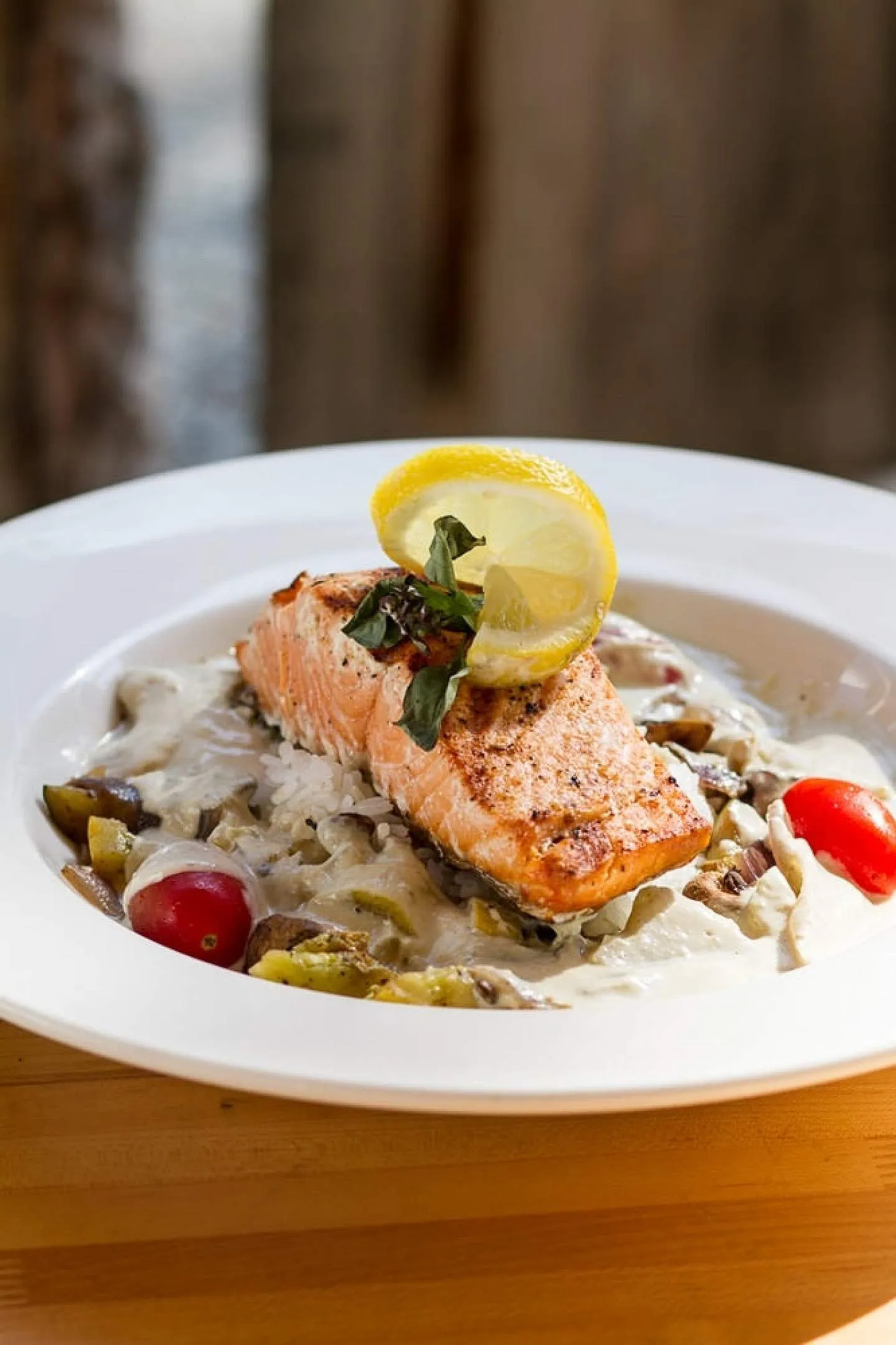 Enjoy classic Alaskan salmon Enjoy classic Alaskan salmon, a staple of what people eat in Alaska
Enjoy classic Alaskan salmon Enjoy classic Alaskan salmon, a staple of what people eat in Alaska
Planning Your travel to las vegas nevada
Plan Your Perfect Mackinac Island Vacation – Your Essential Guide
Exploring Cities In Las Vegas – Uncovering Nearby Wonders 2025
Sockeyes are Alaska’s go-to meat fish—the most commercially important salmon in Alaska, with 20 million to 30 million of the 4- to 10-pounders caught each year. Thousands of Alaskans and visitors target sockeyes with rod-and-reel and personal-use nets. Sockeyes offer a robust flavor profile that many locals rely on. They are a key part of the answer to “What do people eat in Alaska” during the summer fishing season.
Sockeyes are rich and meaty, with a firm red flesh and a medium flavor that’s filling and satisfying. An Alaska staple for summer backyard grilling over open flames, they can also be baked, poached, seared, and smoked, with leftovers used in chowders, soups, cakes, and salmon salad. Sockeyes run June through August, with July being prime time. Many dinner-oriented restaurants will serve sockeyes beginning in July. You can also find them sold fresh in grocery stores and specialty seafood retailers. After the season ramps up, you can often find fresh fillets selling at bargain prices in grocery and warehouse stores.
Coho Salmon
A popular sport fish known for its fight when hooked, coho (or silver) salmon return to Alaska’s rivers from July to October, with the largest concentrations in August and September. While not as commercially important as sockeyes, and also not known for returning in the same dense concentrations, the 8- to 12-pound fish are the most sought-after salmon during the second half of the fishing season. Their lighter taste appeals to many palates.
Cohos have a more delicate and subtle flavor than sockeyes or kings, with the flesh a bit more orange-red than bright red. They’re prepared in the same ways as sockeyes—most often grilled, but also baked, seared, and poached. Some Alaskans argue they hit that just-right sweet spot for taste and texture. You can find them fresh from July to September, with August as prime time. Many dinner-oriented restaurants will serve cohos beginning in late July or early August. You can also find them in grocery stores and specialty seafood retailers, often at about the same price as sockeyes.
Pink Salmon
The smallest Pacific salmon, usually weighing 3 to 7 pounds, pink or humpy salmon converge on rivers and estuaries in vast numbers, dwarfing the catch of all other salmon combined. Male pinks develop a distinctive hump and hooked jaw when spawning (hence the “humpy” nickname.) They’re easy to catch with a rod and reel. While abundant, they have a different place in the Alaskan diet compared to other salmon species when considering what people eat in Alaska.
While a staple of the canning and seafood products industry, pinks are not known for the same rich, oily flavor found in kings, sockeyes, and cohos. With soft, pink flesh and a trout-like presentation, pinks usually don’t make it onto any restaurant menu, unless as an ingredient in salmon cakes or chowder. But if caught ocean-fresh before they’ve begun to morph, pinks are definitely worth grilling, perhaps well-seasoned with a spicy rub. Many Alaskans smoke pinks with tasty results. Don’t hesitate to try canned pinks for salmon salad, chowders, and soups.
Chum Salmon
These feisty, 10-to-15 pound salmon have the largest range of any Pacific salmon, returning to rivers throughout Alaska from July into the fall months. Along the Gulf of Alaska coast, chums (or dog salmon) often spawn in the intertidal reaches of streams, usually intermixed with returning pinks. But some chum populations swim more than 2,000 miles up Interior and Western Alaska rivers, where they’ve long been prized as a traditional dried winter subsistence food for people and dogs.
Many Alaskans don’t eat them. The pinkish-white flesh is generally not oily and lacks the irresistible flavor you’ll find in king, sockeye, and coho fillets. However, some chums that make long-distance migrations have evolved exceptionally high fat content, probably to sustain them on their 1,000-mile-plus spawning migrations. When caught commercially, these are marketed as “Keta” salmon and can rival sockeyes and cohos for their flavor. While less common on plates for many, they hold historical and cultural significance for subsistence living.
Pacific Halibut
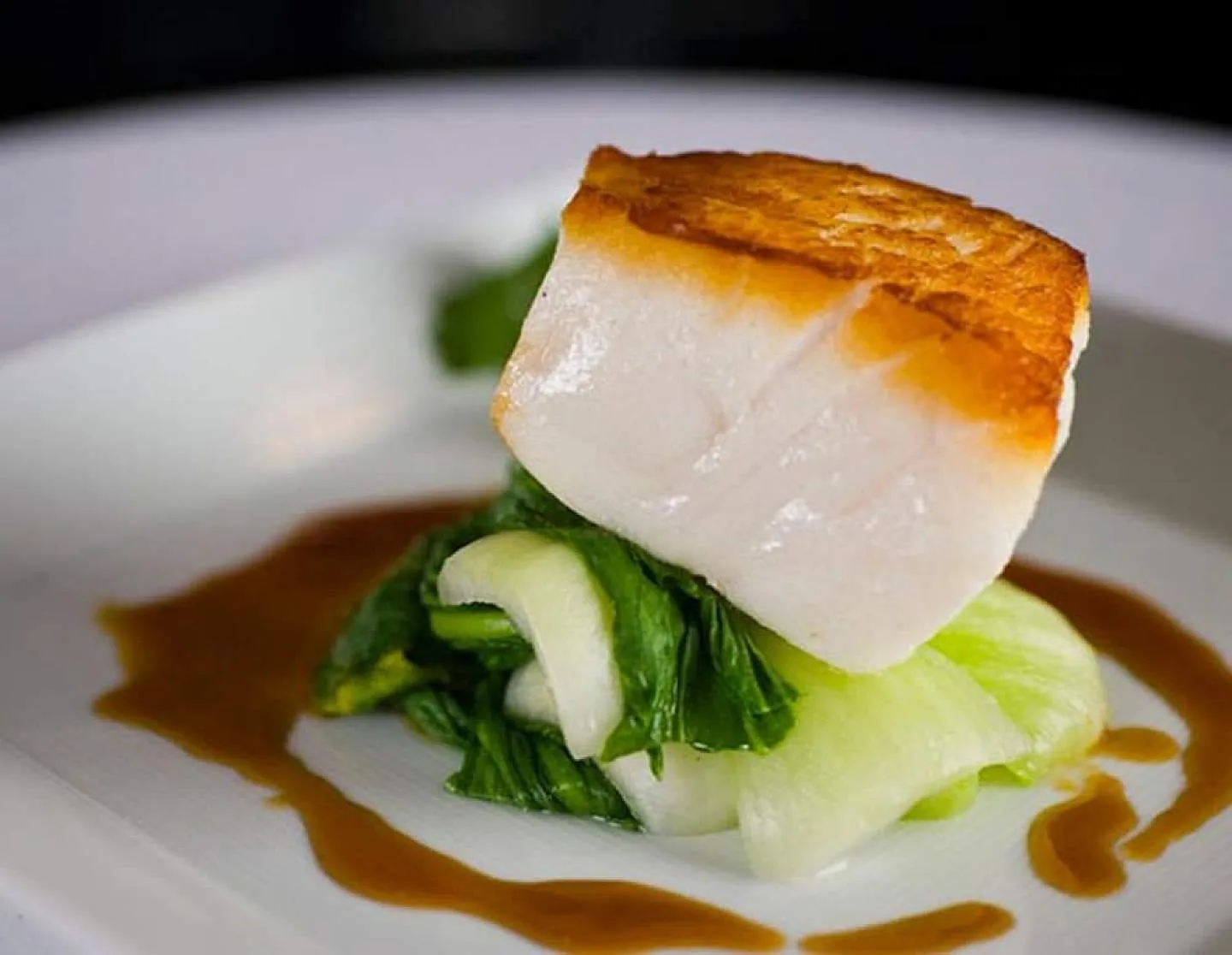 Delectable Alaskan seafood Delectable Alaskan seafood dishes highlighting what people eat in Alaska
Delectable Alaskan seafood Delectable Alaskan seafood dishes highlighting what people eat in Alaska
This Alaskan staple is the region’s most popular deep-sea sport fish and an important commercial catch. Pacific halibut usually feed on the ocean bottom in relatively deep water and range from 20-pound “chickens” to 100-pound-plus “barn doors.” As adults, they have eyes on one side of the head (almost always on the right) with a white belly and a gray-greenish top. Halibut is a must-try for visitors exploring what people eat in Alaska.
The white, flaky meat has a delicate flavor and makes for excellent eating. They’re served grilled, seared, and baked; they come cooked in sauces and within chowders. For a particularly fun meal, try halibut deep fried in beer batter—basically Alaska’s version of boardwalk fish-and-chips. If you’re a purist, go for an expertly grilled fillet that’s lightly seasoned. It can be as good as it gets. Available fresh from spring to fall, with summer months as prime time.
Many dinner-oriented restaurants serve halibut year-round. You can also find them in grocery stores and specialty seafood retailers. Depending on the catch and timing, halibut fillets can be relatively expensive, comparable in cost to Chinook salmon. Watch for bargains in grocery and warehouse stores in June and July.
Rockfish
Yelloweye and black are two of Alaska’s 37 rockfish species—deep-swimming fish that stick close to reefs and other underwater structures. Usually caught as by-catch by commercial halibut vessels, rockfish are also targeted by anglers on deep-sea trips. There are conservations issues that make it important to know which type of rockfish you’re catching. Certain species must be carefully handled and released at depth or they will die. (Catch-and-release fishing is not recommended.) Rockfish offers a milder, sweeter option for those curious about what people eat in Alaska beyond salmon and halibut.
Rockfish meat is white, with a flaky texture and a mild, sweet flavor—considered a treat by many Alaskans. They’re often baked, poached, or broiled. Though not as common as halibut, rockfish show up on menus from spring to fall, with summer months as prime time. Many dinner-oriented restaurants and specialty seafood retailers sell them year around, often at prices comparable to sockeye and coho salmon.
Pacific Cod, Black Cod (Sablefish), and Lingcod
These three groundfish species (only one is a true “cod”) are denizens of the deep ocean off Alaska’s coast. Pacific cod and sablefish will make appearances on restaurant menus, and are usually taken by commercial boats operating far offshore. Lingcod—ferocious predators that are fun to catch—are a favorite target by anglers, often while pursuing halibut. This trio offers varied textures and richness, adding depth to the question of what people eat in Alaska from the deep.
They all exhibit a white flesh with a mild flavor. Pacific cod (the true cod) meat is flaky and light, often deep-fried for fish-and-chips—inexpensive and widely available in grocery stores. Sablefish (or blackcod) are more buttery and rich tasting, considered almost exotic, with prices that rival those for halibut. Some dinner-oriented restaurants serve sablefish, and they can be found irregularly in grocery stores and specialty seafood retailers for a premium. Lingcod presents similar to halibut, just as tasty if perhaps a bit softer, and is not generally available in stores or restaurants.
King Crab
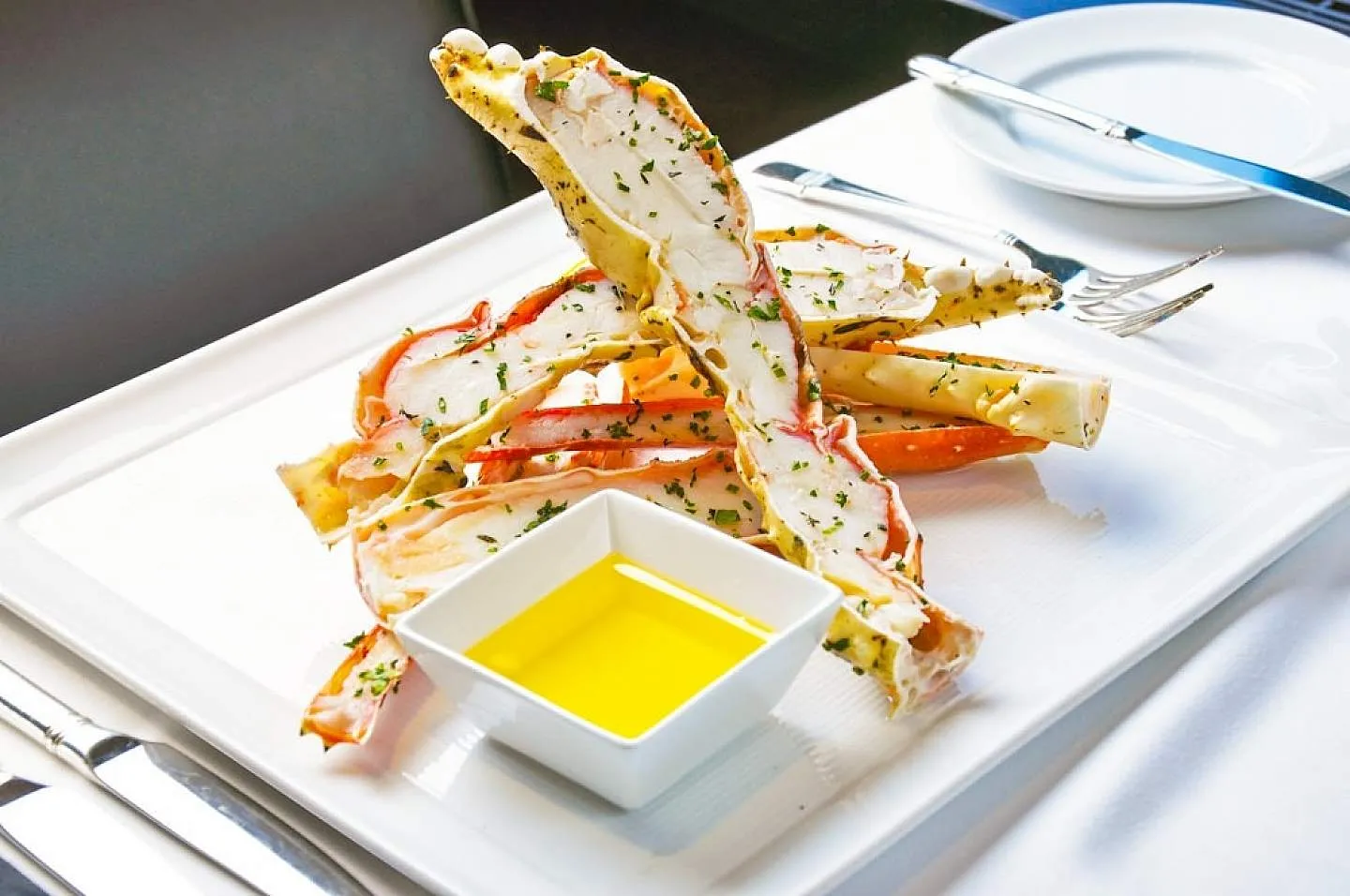 Serving delicious Alaskan king crab Serving delicious Alaskan king crab, a must-try for what people eat in Alaska
Serving delicious Alaskan king crab Serving delicious Alaskan king crab, a must-try for what people eat in Alaska
Alaska king crabs are an authentic world-class delicacy, not to be missed. They’re harvested with pots from the deep waters of the Bering Sea and Southeast Alaska, often with some risk and significant expense. The three commercial species—blue king crab, red king crab, and golden king crab—are 10-legged crustaceans that scavenge and hunt across the sea floor.
They sport a pair of large claws (the right one is usually biggest) and three pairs of powerful legs with meat within the shells. After cleaning, the crabs are steamed and then served broken in half or with the large legs and claws as separate pieces. This is perhaps one of the most iconic answers when asked what people eat in Alaska.
Dinning can be an adventure! You must open the stiff shells with nutcrackers or mallets, and then dig out the meat with special forks. The meat is tender and sweet, with a hint of brine, with the tastiest morsels found in the claws and legs rather than the body. Dip each bite in melted butter to complete the experience. King crab can be some of the most expensive seafood on the menu, and it’s sometimes served to supplement other entrees. Most dinner-oriented restaurants will offer king crab throughout the year, some featuring house recipes for crab cakes, chowders, and bisques. You can also find them sold at specialty seafood retailers for $29 to $34 per pound.
Dungeness Crab
 Fresh Dungeness crab caught in Alaska Fresh Dungeness crab caught in Alaska, part of what people eat in Alaska
Fresh Dungeness crab caught in Alaska Fresh Dungeness crab caught in Alaska, part of what people eat in Alaska
The most widely caught crab in Alaska, dungeness live in relatively shallow near-shore waters and estuaries from the Gulf of Alaska through Southeast on down the coast, all the way to Mexico. Smaller than king crab, (and often half as expensive!) dungeness are true crabs, with four legs for traveling and a pair of pinching claws up front. They’re targeted both by Alaskans for personal or subsistence use, and by commercial operators.
To avoid any chance of paralytic shellfish poisoning, the crabs must be butchered before cooking, with the legs and claws boiled for about 20 minutes. You eat them the same way you eat other crab—cracking open the legs and claws for a bite of tender, sweet meat with a hint of the ocean. They make for very tasty crab cakes. This accessible and delicious crab is a common answer to what people eat in Alaska from the crustacean world.
Snow Crab
One of the most important commercial catches in Alaska, two species of snow crab (tanner crab) are harvested from the Bering Sea and the Gulf of Alaska. The opilio variety is a bit smaller than the bairdi, but both share the same sweet, tender, and slightly salty meat, with a more delicate flavor than dungeness or king crab. With smaller legs and pinchers, snow crabs often show up accompanying salad bars (sometimes all you can eat). Depending on the season, they’re about as expensive as dungeness. Snow crab provides another sweet and delicate option for seafood lovers.
Wild-Caught Shrimp and Scallops
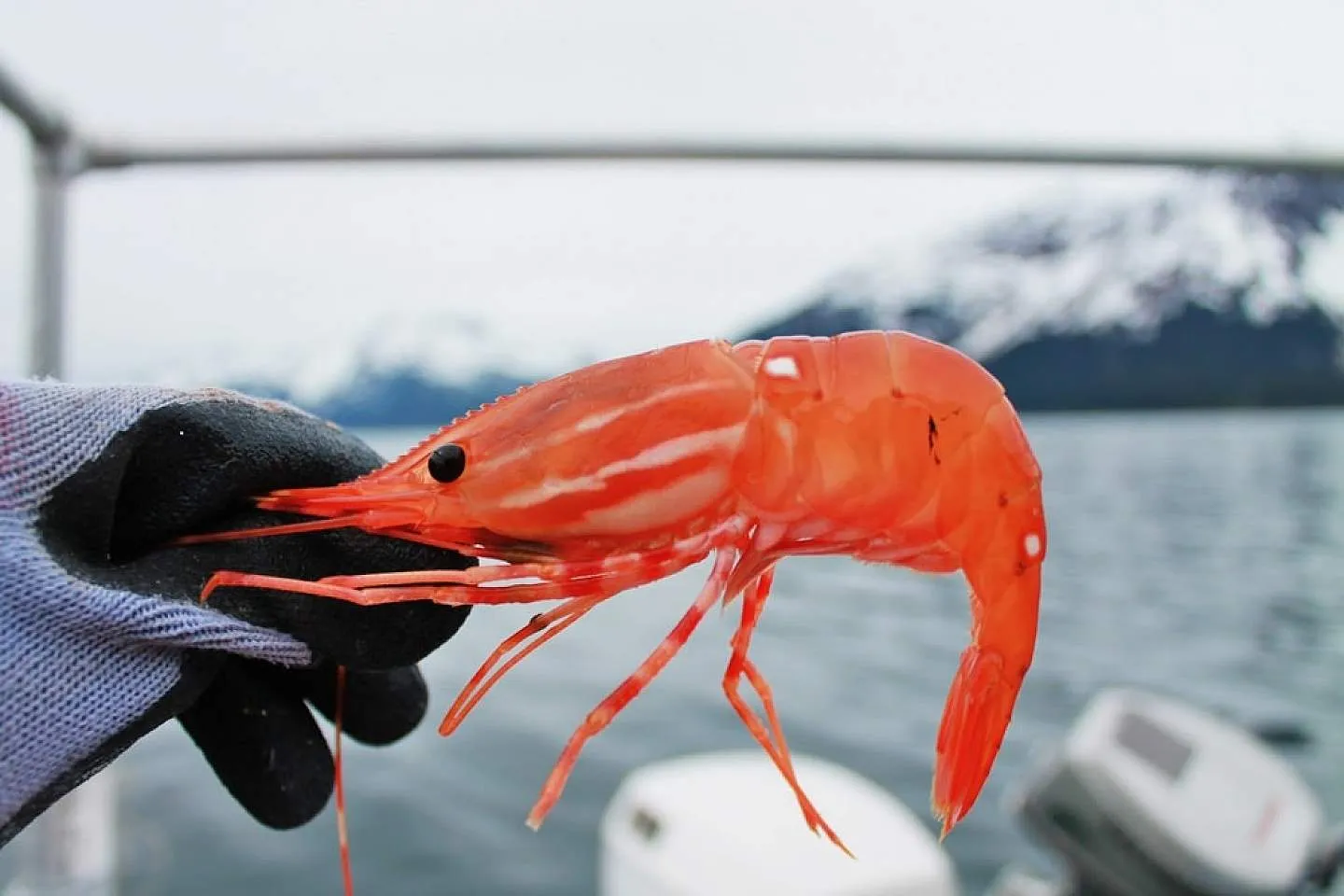 Fresh wild-caught Alaskan shrimp Fresh wild-caught Alaskan shrimp, a delicious component of what people eat in Alaska
Fresh wild-caught Alaskan shrimp Fresh wild-caught Alaskan shrimp, a delicious component of what people eat in Alaska
What do two species of Alaska shrimp and one Alaskan bivalve have in common? They’re uncommonly sweet when eaten fresh! Don’t pass them up if they appear on menus during spring to fall seasons, or on sale in grocery stores or seafood specialty shops. These deliver a very different epicurean experience than you’ll get from frozen shrimp or scallops you find elsewhere. Experiencing the freshness of these locally sourced delights is a highlight of exploring what people eat in Alaska.
Alaska-Grown Pacific Oysters
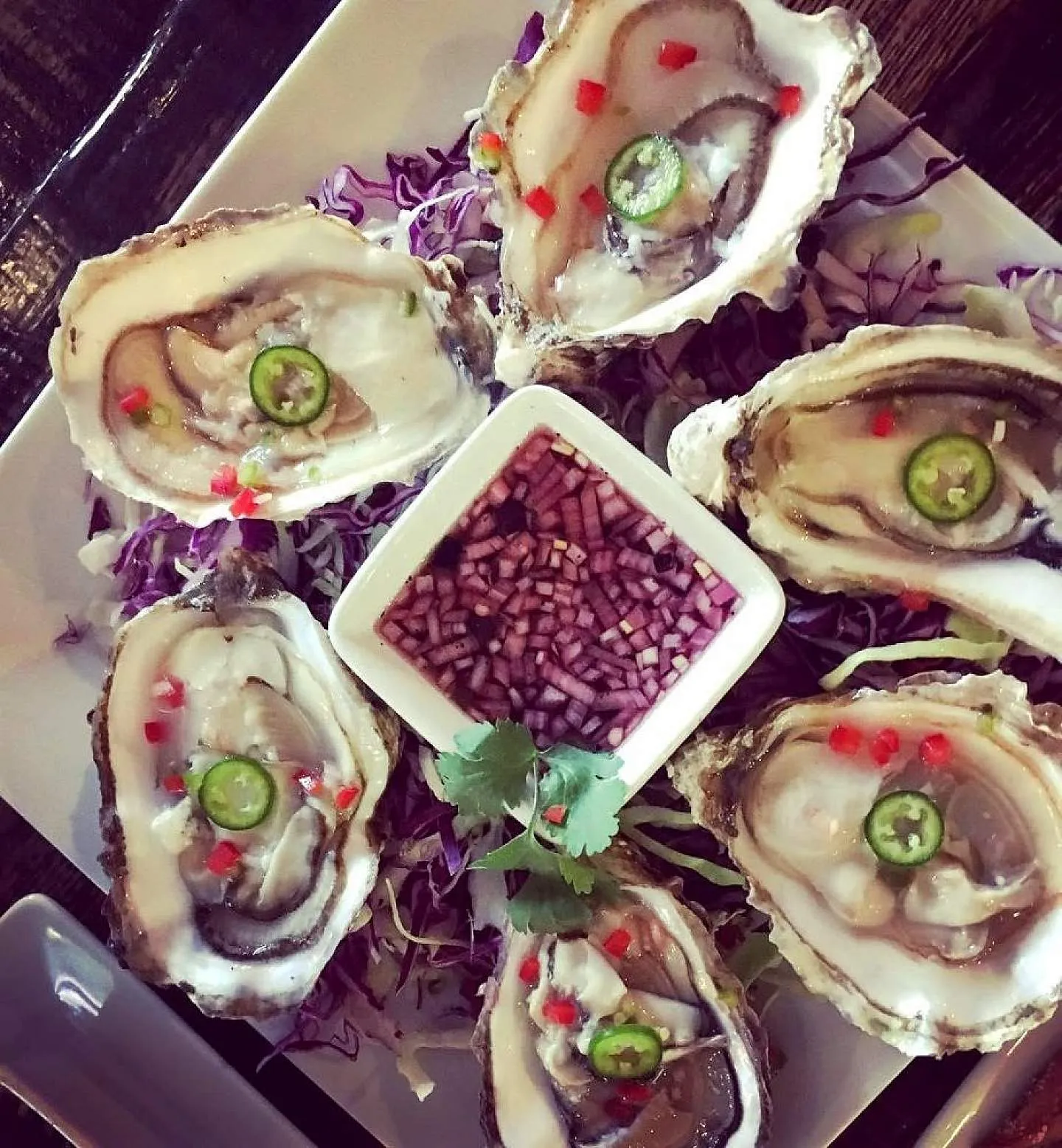 Sampling Alaska-grown Pacific oysters Sampling Alaska-grown Pacific oysters, a unique part of what people eat in Alaska
Sampling Alaska-grown Pacific oysters Sampling Alaska-grown Pacific oysters, a unique part of what people eat in Alaska
Alaska’s pristine waters support a small-but-growing oyster farm industry that produces exceptionally firm, consistent, and sweet half-shell products. Estuaries and near-shore passages may provide the proverbial sweet spot for growing perfect oysters. On one hand, the cold temperatures of Alaska’s ocean delays maturation, preventing the oysters from reproducing (which makes them soft, milky-colored and unpalatable.) At the same time, the coastal currents are so rich in plankton that the oysters grow quickly despite the chillier temps, ready for harvest in 18 to 36 months. The result makes for a unique dining experience.
About 60 aquatic farms spread across the state—in Kachemak Bay, Prince William Sound, and Southeast Alaska—sell nearly two million oysters a year. You can find them in many dinner-oriented restaurants and specialty seafood retailers from under $2 per oyster and on up. Eat them raw, baked, or in sauces. These local gems offer a distinct taste of the Alaskan marine environment.
Other Exotic Alaskan Seafood
Commercial harvest of razor clams has occurred in Alaska for more than a century, and these clams are widely available. A few aquatic farms are producing blue mussels—the small, blue-black bivalves that rule the intertidal zone—in small-but-growing quantities. Divers gather giant geoduck clams in a fishery based in southeast Alaska. A few entrepreneurs have started harvesting kelp and other wild seaweed under permits, mostly in Southeast Alaska. Watch for these less common seafood products irregularly on menus, seafood specialty shops, and farmer’s markets. For the adventurous palate, these offer further insight into the diverse answer to what people eat in Alaska.
Beyond the Ocean: Wild Game and Meats
While seafood dominates the commercial scene, wild game holds significant cultural and historical importance in Alaska, particularly for Native communities and local hunters. When considering what people eat in Alaska, especially in more remote areas or private homes, game meats are a vital part of the diet, reflecting a deep connection to the land and sustainable harvesting traditions.
Moose and caribou (and other traditional game meats like black bear, Sitka black-tailed deer, Dall sheep, mountain goat, and porcupine) are not harvested for commercial use in Alaska, so you won’t find them on the restaurant menu or in the meat aisle. But if you make friends with an Alaskan who hunts—and this local invites you to dinner—don’t hesitate to slip in a request. Moose, deer, caribou, and sheep can make for superb eating as steak or roasts, with a presentation as tender and rich as organic beef. They can be processed into a variety of cuts, sausages, jerkies, and stew meats. Experiencing these is a truly authentic taste of Alaskan life.
Reindeer
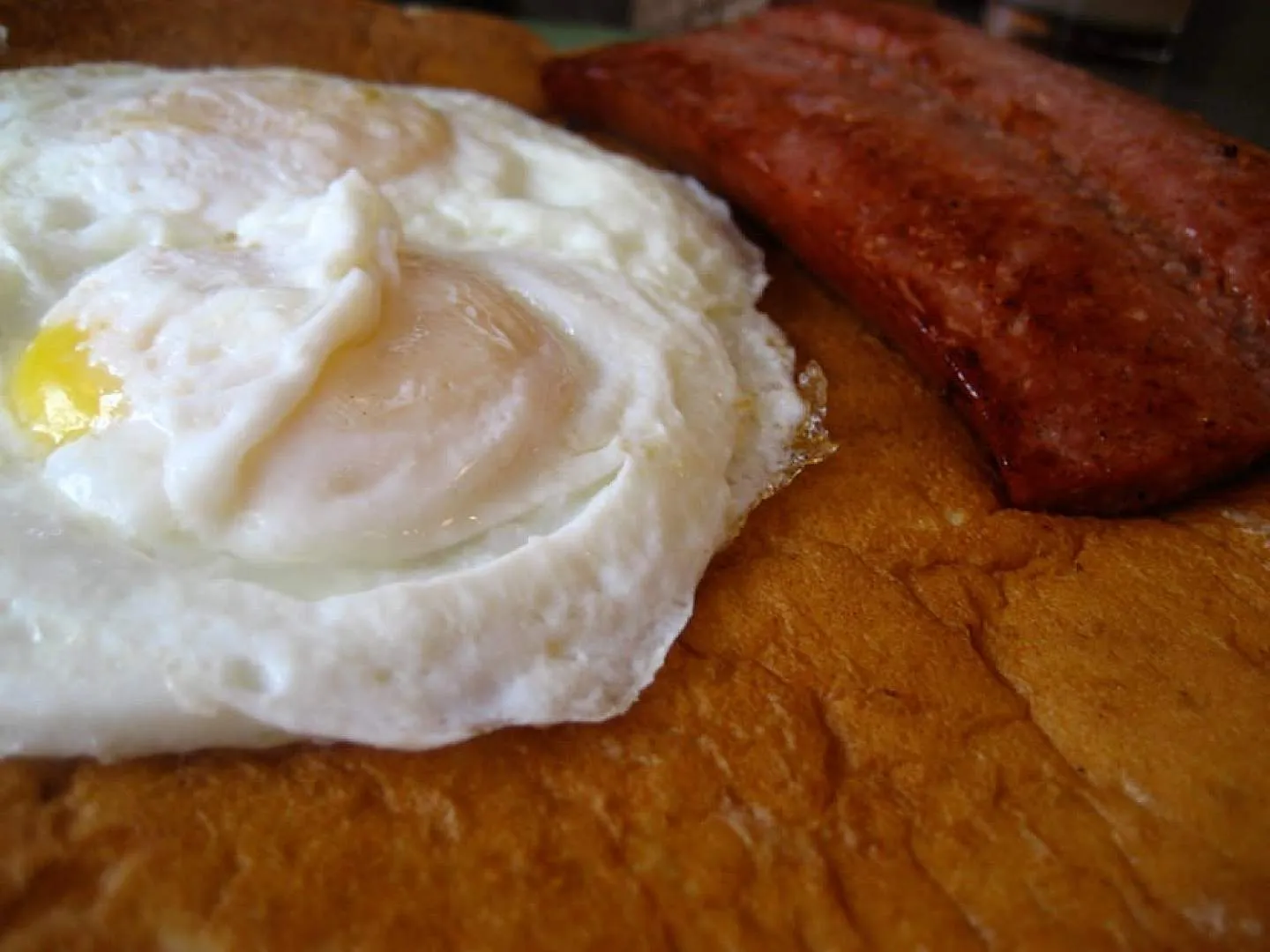 Authentic Alaskan reindeer sausage for breakfast Authentic Alaskan reindeer sausage for breakfast, showing what people eat in Alaska
Authentic Alaskan reindeer sausage for breakfast Authentic Alaskan reindeer sausage for breakfast, showing what people eat in Alaska
This is a must-try Alaska experience! Essentially a domestic caribou, Alaskan reindeer are descended from stock imported from Siberia during the 1890s and can only be owned by Alaskan Natives. About 18 herders manage about 20,000 animals that forage in western and northwestern Alaska, mostly on the Seward Peninsula. Reindeer meat, especially in sausage form, is one of the most accessible ways for visitors to sample Alaskan game.
Sausage containing reindeer is on the breakfast menu of almost every full-service restaurant in the state. It has a distinctive, meaty taste reminiscent of a high-end link pork sausage. Prepared meats (usually various kinds of sausage) containing reindeer are sold in most grocery stores. Also check what’s available at Indian Valley Meats and Alaska Sausage and Seafood. Some street vendors and restaurants offer very tasty reindeer hot dogs at about twice the price of a regular dog. Trying this unique meat provides a glimpse into the non-seafood aspect of what people eat in Alaska.
Marine Mammals
Strictly protected under federal Marine Mammal Protection Act, Alaskan whales, seals, walruses, sea lions, and sea otters can be harvested by Alaska Natives for consumption and subsistence. They are not generally available for sale to the non-Native public, but it’s complicated. For example, edible parts of certain non-threatened or non-endangered species may be sold inside Native villages by individuals to non-Natives for consumption. This practice highlights the deep cultural roots of what people eat in Alaska, particularly within indigenous communities.
Owing to their large populations of people with Alaska Native heritage, Alaska’s three biggest cities—Anchorage, Fairbanks, and Juneau—in some circumstances qualify as “villages” under this law. So it may be possible to purchase these traditional Native foods in the towns, more likely if you travel to a traditional village.
The most likely morsel available would probably be a hunk of muktuk—whale skin with fat still attached. This Native cultural staple will present with an intense marine “fishy” flavor, both rich and chewy. Check with village stores or ask Native people who have a personal hunting connection. Still, make sure you follow federal rules. While not widely available, understanding this part of the diet is essential to comprehending the full scope of what people eat in Alaska historically and culturally.
Freshness from the Land: Alaskan Produce and Berries
The long hours of daylight during the Alaskan summer create unique growing conditions, resulting in some exceptionally sweet and flavorful produce. While commercial agriculture is limited compared to other states, locally grown fruits and vegetables are a cherished part of what people eat in Alaska when in season.
Alaskan Fruits and Vegetables
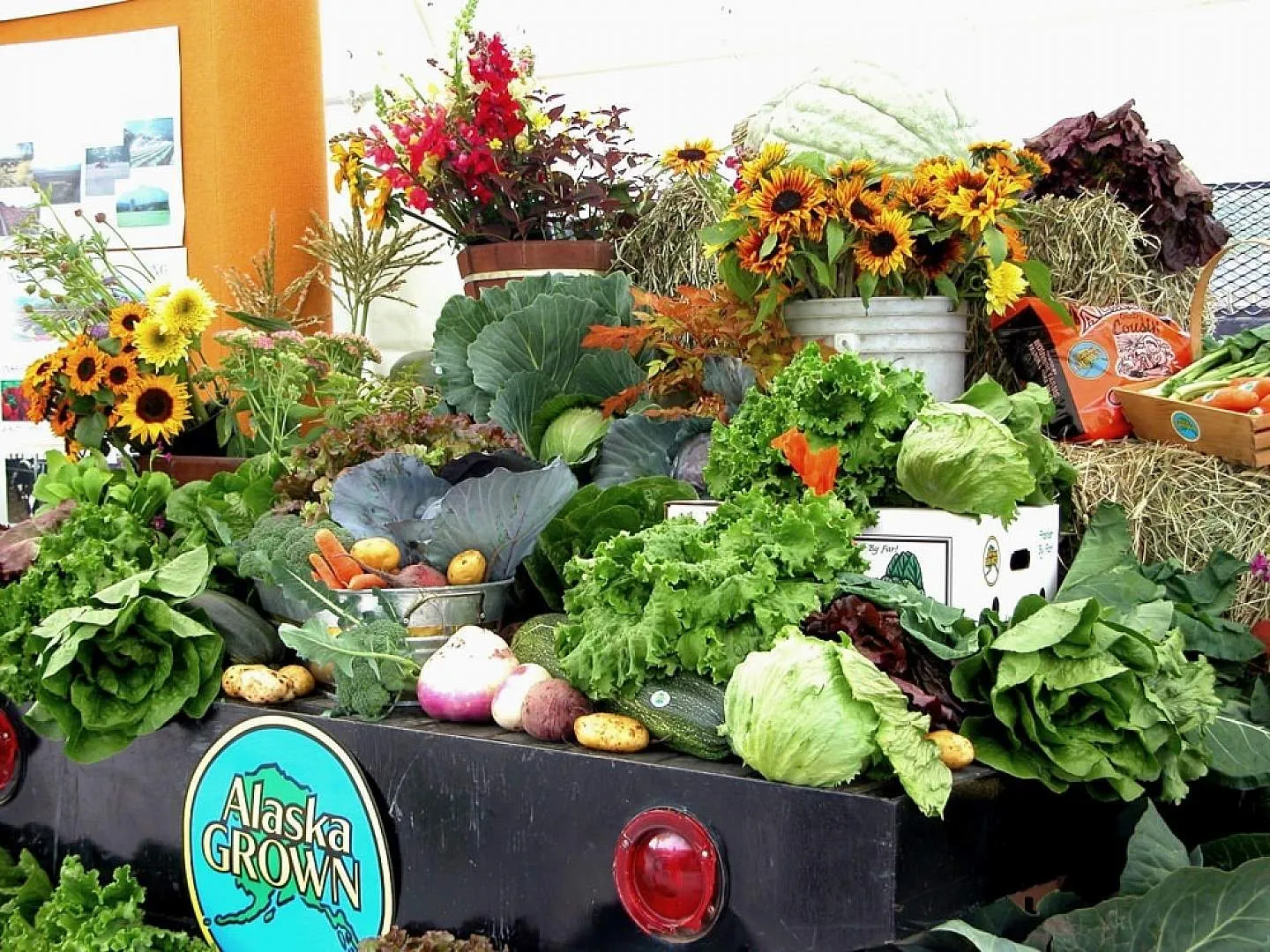 Unique Alaskan produce grown under the midnight sun Unique Alaskan produce grown under the midnight sun, contributing to what people eat in Alaska
Unique Alaskan produce grown under the midnight sun Unique Alaskan produce grown under the midnight sun, contributing to what people eat in Alaska
If you have a chance to eat locally grown food, jump on it! The land of midnight photosynthesis produces crops that are exceptionally sweet and feature complex flavors, especially among the varieties that thrive in colder soils. The cruciferous family—broccoli, cauliflower, and cabbage—grow well all over the state. Zucchini and summer squash thrive. Peas and bush beans are favorites. Potatoes—especially the Yukon Gold variety—are exceptionally sweet and tender when boiled whole or oven-baked in slices. Alaska also features several thriving greenhouse operations that produce tomatoes (plus flowers and vegetable starts).
Locally grown apples and berries are also available. Many productive apple varieties can thrive once they’re grafted onto a cold-ground rootstock (often Siberian crab apple varieties) and transplanted to favorable orchard or garden sites. Look for locally cultivated raspberries, strawberries, and blueberries as well. Still, Alaska’s overall agricultural scene is relatively small, probably less than the production found in any county of a Midwest farm state. As a result, local produce is not widely available in regular grocery stores, and makes infrequent appearances on restaurant menus.
Here are a few ways to sample them. Check farmer’s markets. Most communities feature a farmer’s market venue, or hold one on special days. More than half dozen of these markets are held during the spring-to-fall growing season. And in Anchorage, for instance, you’ll find much more than produce for sale—arts and crafts, clothing, unique honeys and sauces, and other foods. It’s a great way to go hyper-local and meet real Alaskans! Alaska Pacific University holds a weekly farmer’s market on campus, with produce from the school’s Matanuska Valley experimental farm and other vendors. Pick your own.
Farms offering a chance to conduct a personal harvest are scattered around the state, with a particularly tasty option found at certain venues in the Palmer area of the Matanuska Valley, ground zero for Alaska commercial agriculture. These markets and farms offer a direct answer to where and what people eat in Alaska from the plant world.
Wild Berries
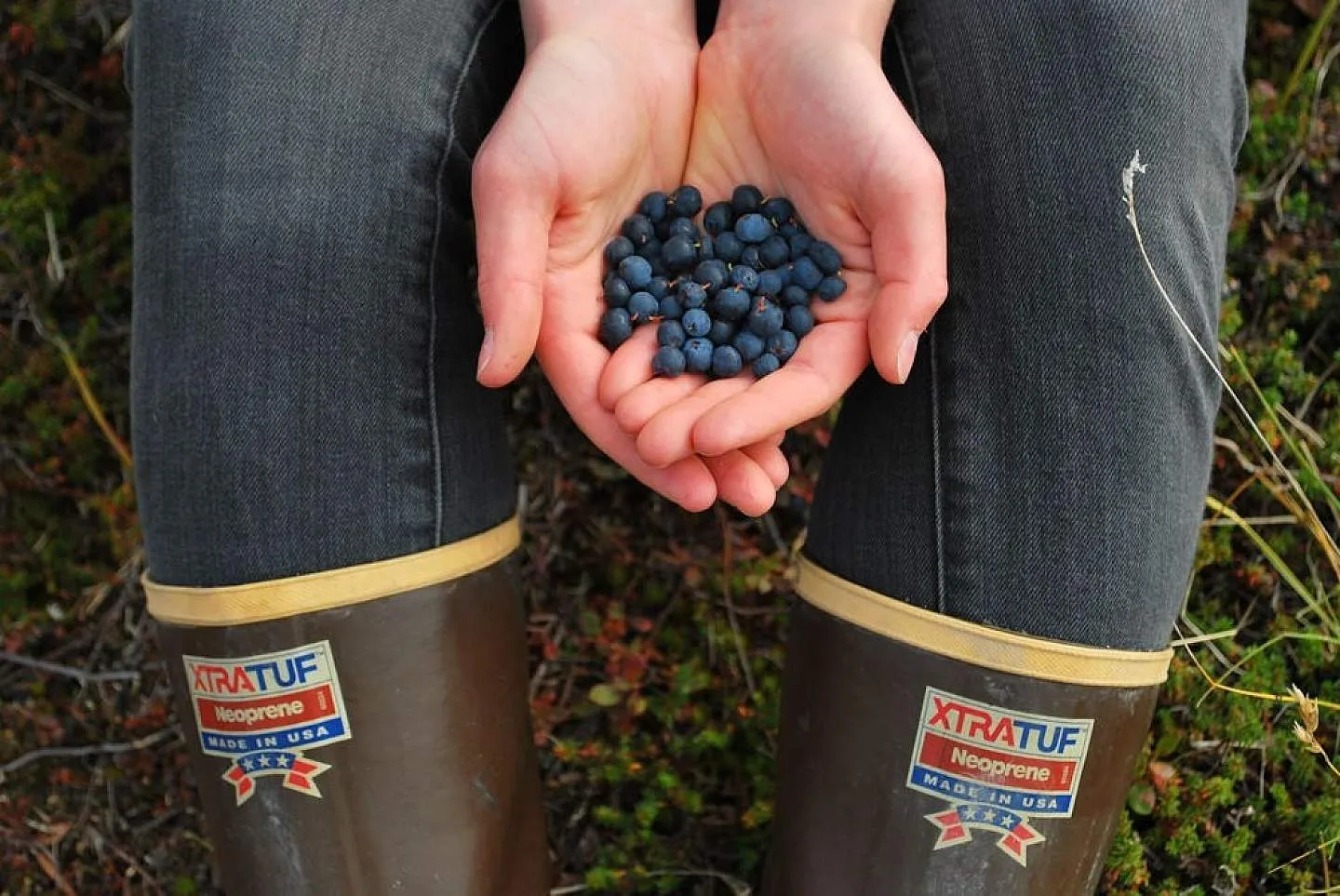 Delicious wild Alaskan blueberries Delicious wild Alaskan blueberries, a key part of what people eat in Alaska seasonally
Delicious wild Alaskan blueberries Delicious wild Alaskan blueberries, a key part of what people eat in Alaska seasonally
Alaska’s wild lands produce an extraordinary annual berry crop. A dozen species ripen every August and September—from sea level rainforests to the open tundra of the alpine zone. During a good season, blueberry patches will be so prolific that pickers often have trouble finding a place to sit down without staining their clothes. These blueberries—several species that closely resemble each other—are considered one of nature’s “superfoods,” replete with anti-oxidants and vitamins that boost immunity and brainpower.
But that’s not why Alaskans harvest gallon after gallon. Alaskan wild berries—from the sweet alpine blueberries to the tart wetland salmonberries—can be so abundant that it’s like the country has transformed into a gigantic “you pick” farmstead. Don’t hesitate to park at a highway trailhead and meander into the hills with a bucket or a bag, if visiting from late July through fall. In mid-to-late August especially—the Alaska berry “sweet spot”—watch for pullouts or trailhead lots jammed with local vehicles. It’s your signal that the berries are ripe. This foraging tradition is deeply ingrained in what people eat in Alaska.
In Anchorage, check out Arctic Valley Ski Area at the top of Arctic Valley Road or “Blueberry Hill” above the Glen Alps trailhead into Chugach State Park (on the trail to Flattop Mountain). Additional productive gathering can be found off trailheads along the Seward Highway through Turnagain Pass, with the most productive berry slopes above about 600- to 800-foot elevation level. From either Turnagain Pass parking areas, head upslope and spread out.
From the east-side lot, take the trail toward the mountains. Go right over the bridge to catch the Center Ridge Trail or go left up a grade onto the new Turnagain Pass Trail. Blueberry patches are scattered throughout the spruce and hemlock, often along the edges of clearings. Salmonberries and wild raspberries can also be prolific, especially in wetter ground.
Ripe varieties will range from grey-blue to almost black, depending on the species and immediate growing conditions. Very generally, alpine blueberries grow close to the ground on open slopes and can be surprisingly sweet. Mixed among them are gobs of black crowberries, which are bland. In open forest glades, look for shrubs and small bushes with blueberries that are tart and tangy, some black-hued and as large as small grapes.
Avoid all white berries (they’re poisonous) and be cautious of single red berries. Check out our berry primer for more information. Spit out any berry that tastes bitter or chalky. Don’t want to pick your own? Check farmer’s markets for wild product gathered by intrepid locals, or stop by Alaska Wild Berry Products in Anchorage or Kahiltna Birchworks in Talkeetna for products made with wild Alaskan berries.
Alaskan Drinks: Craft Beer, Wine, and Spirits
The Alaskan beverage scene is surprisingly vibrant, with a strong emphasis on local production and unique flavors often inspired by the state’s natural bounty. While the climate might pose challenges, Alaskans have found creative ways to craft excellent drinks that complement their food, expanding the answer to what people eat in Alaska to include what they drink.
Craft Beer
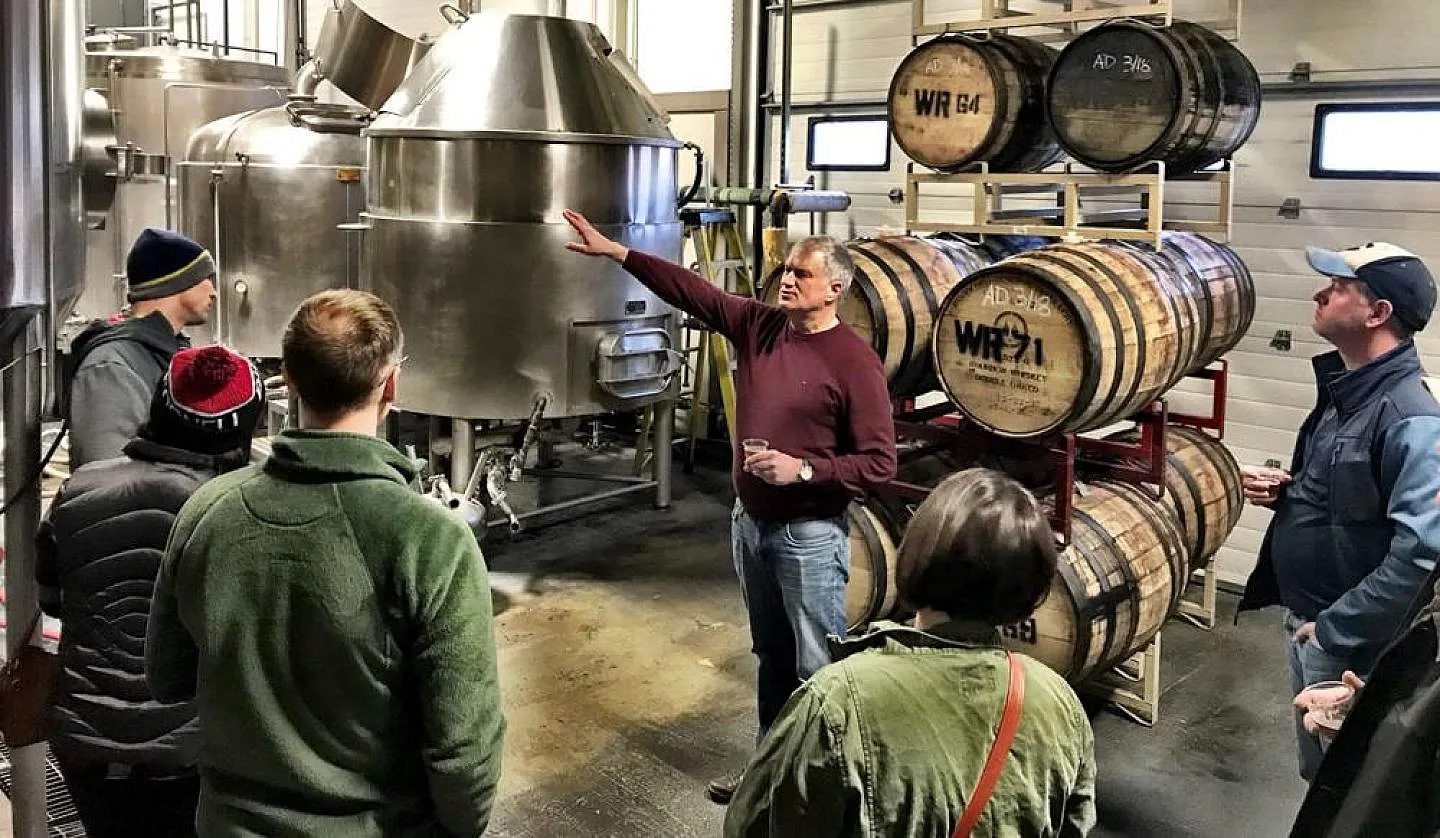 Sampling Alaskan craft beer on a brewery tour Sampling Alaskan craft beer on a brewery tour, reflecting what people drink and eat in Alaska
Sampling Alaskan craft beer on a brewery tour Sampling Alaskan craft beer on a brewery tour, reflecting what people drink and eat in Alaska
Alaska has a thriving craft beer scene, with more than 35 microbreweries operating in at least 20 communities around the state. The ales, lagers, and pilsners are often associated with a specific restaurant or pub. Anchorage, in particular, features several popular venues, some with visible brewing tanks. Trying a local brew is a perfect way to wash down all that delicious Alaskan food.
Big Swig Tours is a great way to sample fresh tapped beer, with tours of several different flavors, including one where you bike brewery-to-brewery and another where you ride the Alaska Railroad. The state also boasts an award-winning regional brewery with national distribution—the Alaskan Brewing Company, in Juneau. Alaskan’s signature beer is the Amber, available in just about every restaurant and bar in the state.
Wine
Alaska’s climate may not be ideal for vineyards, but that hasn’t stopped a few enterprising vintners from creating a few only-in-Alaska varieties, using both imported juice and Alaskan wild berries. Check out Bear Creek Winery in Homer for a tour where you can sample blueberry and raspberry wines. Denali Winery in Anchorage specializes in crafting personal wines for special order in their South Anchorage facility. Try a flight of six wines. These unique berry wines offer a distinctly Alaskan twist on the beverage landscape.
Spirits
Alaska’s distillery scene is relatively young. Producers are often mom-and-pop operations that offer intimate settings for sampling. It’s another great way to meet real Alaskans! In Alaska’s largest city, the Anchorage Distillery produces a moonshine whisky, gin, and several varieties of vodka, often with Alaska-grown grains and wild berries as ingredients. Visit the tasting room or take a tour. These local distilleries are adding new dimensions to what people eat (and drink) in Alaska.
Sweet Treats: Alaskan Birch Syrup and Fireweed Honey
Beyond the main courses and beverages, Alaska offers unique sweet ingredients derived from its forests and wildflowers. These natural syrups and honeys provide a distinct local flavor profile that is increasingly popular, showing another side of what people eat in Alaska.
Alaskan Birch Syrup
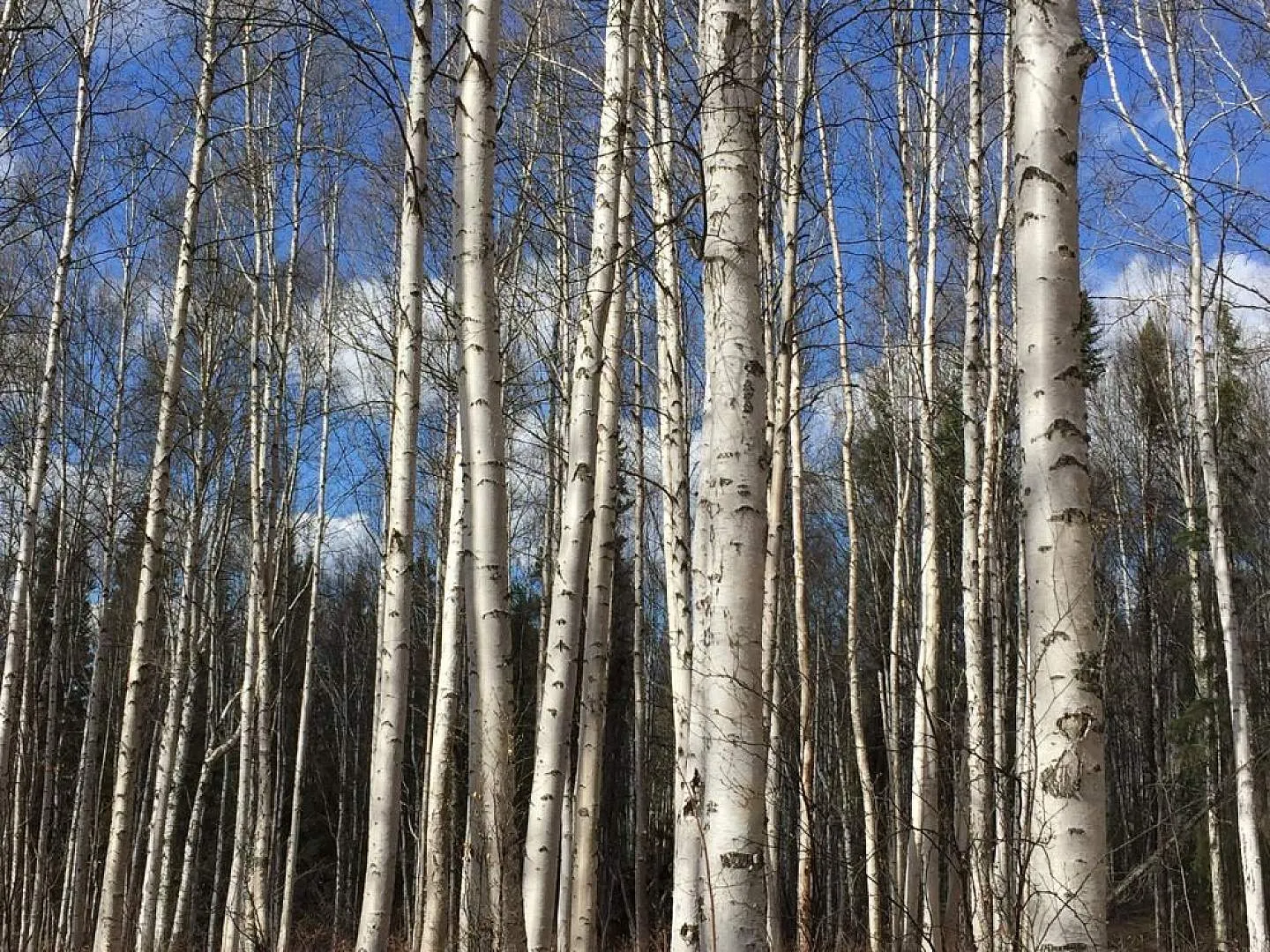 Alaskan birch syrup Alaskan birch syrup, a unique sweet treat to find among what people eat in Alaska
Alaskan birch syrup Alaskan birch syrup, a unique sweet treat to find among what people eat in Alaska
When the sap runs during a three-week season every April, a handful of entrepreneurs tap wild birch trees across the state. It’s a labor-intensive process—100 gallons of sap must be collected in the field, then evaporated over carefully tended fires, to make a single gallon of concentrated syrup. Freshness and processing are key. The product is delectable—thinner than maple syrup, with a more delicate taste that’s not as overwhelmingly sweet. Some people say it has a nutty flavor, or sometimes offers a hint of wild raspberry. Birch syrup is a truly unique Alaskan delicacy.
Birch syrup is sold irregularly in grocery stores, but you can find it more frequently in specialty shops like Alaska Wild Berry Products, Kahiltna Birchworks, and Natural Pantry. Alaska’s farmer’s markets or fairs with vendors may be the very best venues to find the elixir on sale, often offered by the very people who tromped through melting snow with buckets and tubes the previous spring. It’s comparable in price to fine maple syrup. Use it to flavor sweets, pour on pancakes, dribble over ice cream (Anchorage’s Wild Scoops has pioneered a unique birch flavored ice cream)—anything that begs for that sweet, boreal touch. These products add a special touch to the list of what people eat in Alaska.
Fireweed Honey
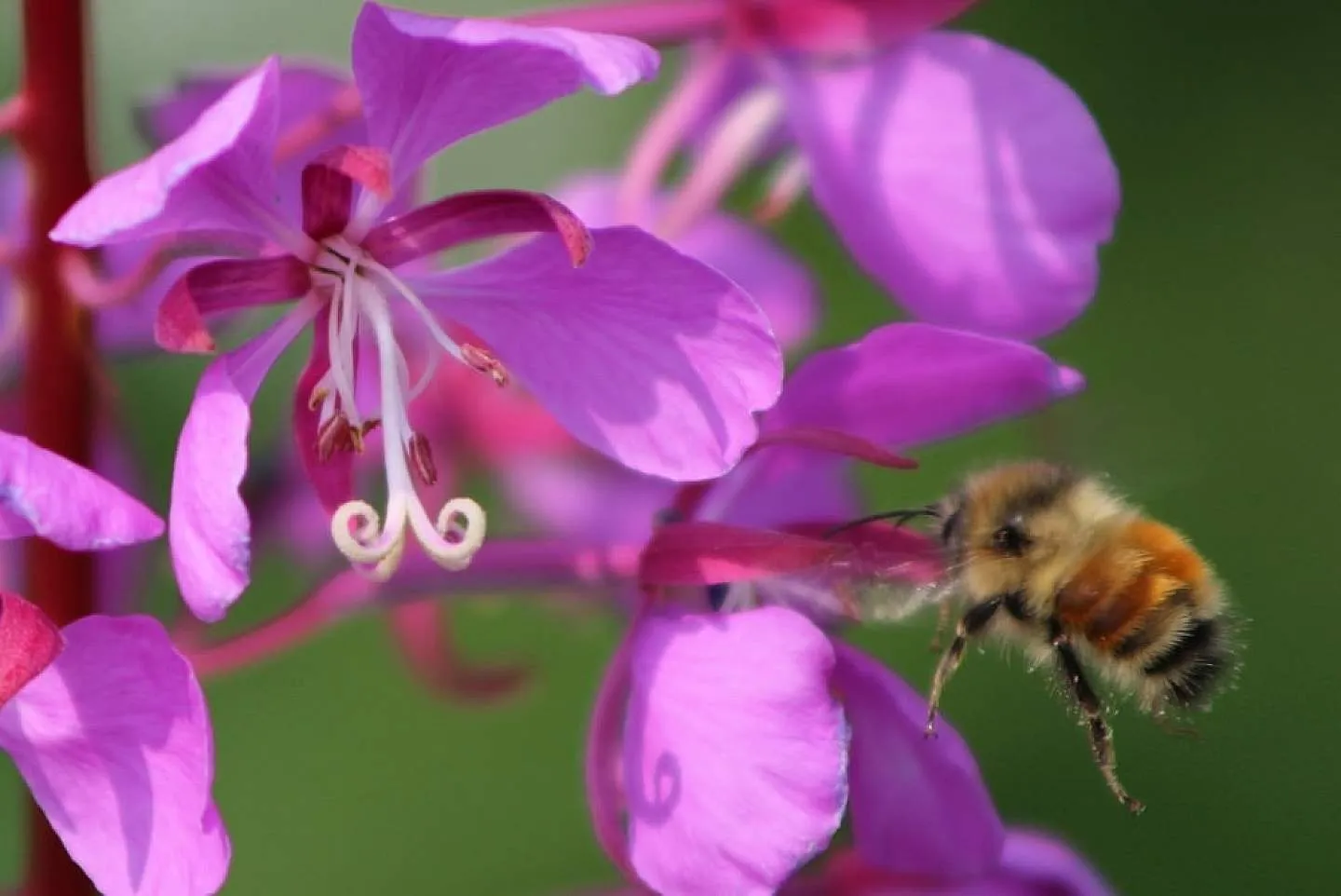 Alaskan fireweed honey Alaskan fireweed honey, a local delicacy showcasing what people eat in Alaska
Alaskan fireweed honey Alaskan fireweed honey, a local delicacy showcasing what people eat in Alaska
Scores of Alaskans have embraced the fine art of bee-keeping, with apiaries spread across the state, including many locations inside the Anchorage urban area. For the most part, bees must be imported in the early spring and do not survive the winter. But once the colony is up and buzzing, the worker bees fan out to work over the state’s prolific natural crop of wildflowers.
The honey produced can be remarkable—lighter and more liquid than many commercial varieties, and laced with complex flavors that hint at the boreal summer. Where the bees forage in locales dominated by fireweed—that tall violet-red wildflower that thrives in former wildfire burns and any disturbed ground—they produce some of the most subtle and flavorful honey of all.
Local honey can be found in some regular grocery stores, as well Alaska Wild Berry Products and Natural Pantry. Alaska’s farmer’s markets or fairs with vendors often feature dedicated apiculturists selling their products in person. Fireweed honey offers a sweet taste of the Alaskan wilderness.
Alaskan Coffee
Alaskans love fresh coffee, and many vendors draw on beans that have been roasted in-state. Most operations have their own shops, as well as distribution networks into many other venues. Kaladi Brothers Coffee pioneered the Anchorage scene back in the 1990s, and their signature brews can be found throughout the state. For an old-fashioned, open-a-book-and-get-comfortable coffee shop, check out the operation’s original cozy cafe on Brayton Drive, up the east-side frontage road of the Seward Highway north of the Dimond/Abbott northbound exit. While not technically “food,” coffee is a crucial part of the daily diet and culture, certainly part of what people eat and drink in Alaska.
Frequently Asked Questions About What Do People Eat In Alaska
Here are some common questions about the unique food scene in the Last Frontier:
- Is Alaskan seafood sustainable? Yes, Alaska is a leader in sustainable fisheries management, with strict regulations ensuring the health of fish populations for future generations. Wild-caught Alaskan seafood is generally considered one of the most sustainable options globally.
- Can I eat wild game in Alaska restaurants? No, wild game harvested through sport or subsistence hunting cannot be sold in restaurants in Alaska due to regulations. However, commercially farmed reindeer meat is widely available in restaurants, usually in sausages.
- What are common Alaskan berries? Alaskan wild berries include blueberries (several varieties), salmonberries, raspberries, crowberries, and highbush cranberries. They are typically ripe in late summer and early fall.
- Is Alaskan birch syrup the same as maple syrup? No, birch syrup is thinner than maple syrup and has a more delicate, less overwhelmingly sweet flavor, often described as nutty or with hints of fruit. It is also much more labor-intensive and expensive to produce.
Conclusion
Exploring what people eat in Alaska offers a delicious journey into the state’s unique environment and rich cultural history. From the unparalleled bounty of the ocean providing exquisite salmon and crab, to the game meats rooted in tradition, and the sweet produce and berries nurtured under the midnight sun, Alaskan cuisine is a reflection of its wild, untamed spirit. Add in the growing scene of craft beverages and unique local syrups, and you have a culinary landscape that is as fascinating and rewarding as the state itself. When you visit Alaska, be sure to savor these local flavors – they are an essential part of the Alaskan experience.
